Volume indicators are essential tools for successful scalping in the forex market. These powerful technical analysis instruments provide crucial insights into market activity, helping traders identify potential entry and exit points with precision. The best volume indicators for scalping include On-Balance Volume (OBV), Chaikin Money Flow (CMF), Volume Rate of Change (VROC), Money Flow Index (MFI), and Volume Weighted Average Price (VWAP). By effectively utilizing these indicators, scalpers can enhance their trading strategy, boost profitability, and gain a significant edge in the fast-paced world of forex trading.

This comprehensive guide will delve into the intricacies of volume-based scalping, exploring how these indicators work and providing specific strategies for their implementation. Whether you’re a seasoned scalper or just starting your forex trading journey with an online forex broker, understanding and mastering volume indicators is essential for making informed decisions in the volatile forex market.
By the end of this article, you’ll have a thorough understanding of how to leverage volume indicators for scalping, including practical strategies for each indicator and advanced techniques to take your trading to the next level. Let’s dive into the world of volume-based scalping and discover how these indicators can transform your trading approach.
Understanding Volume Indicators in Forex Scalping
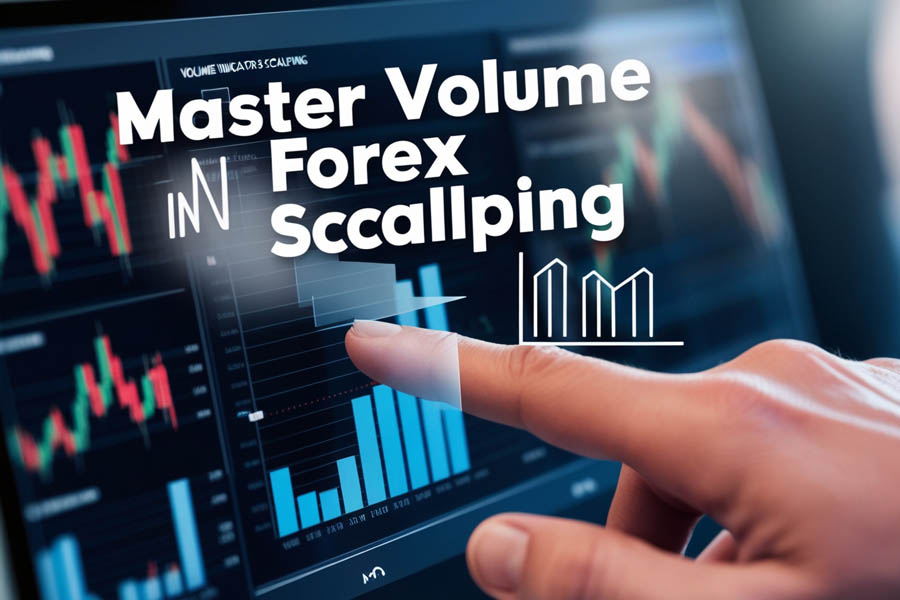
What Are Volume Indicators?
Volume indicators are technical analysis tools that measure the intensity of trading activity in a particular market. In forex scalping, these indicators help traders gauge the strength of price movements and identify potential trend reversals or continuations.
Why Are Volume Indicators Crucial for Scalping?
- Market Sentiment Analysis: Volume indicators provide insights into market sentiment, helping scalpers understand whether buyers or sellers are dominating the market.
- Confirmation of Price Movements: By correlating price action with volume, traders can confirm the strength of trends and make more confident trading decisions.
- Identifying Potential Reversals: Sudden spikes or drops in volume can signal potential trend reversals, allowing scalpers to adjust their positions accordingly.
- Enhanced Timing: Volume indicators help scalpers time their entries and exits more effectively, maximizing profit potential while minimizing risk.
Read More: The Ultimate Guide to Divergence Scalping
Top Volume Indicators for Scalping

1. On-Balance Volume (OBV)
The On-Balance Volume indicator is a cumulative measure of buying and selling pressure. It calculates a running total of volume, adding volume on up days and subtracting it on down days.
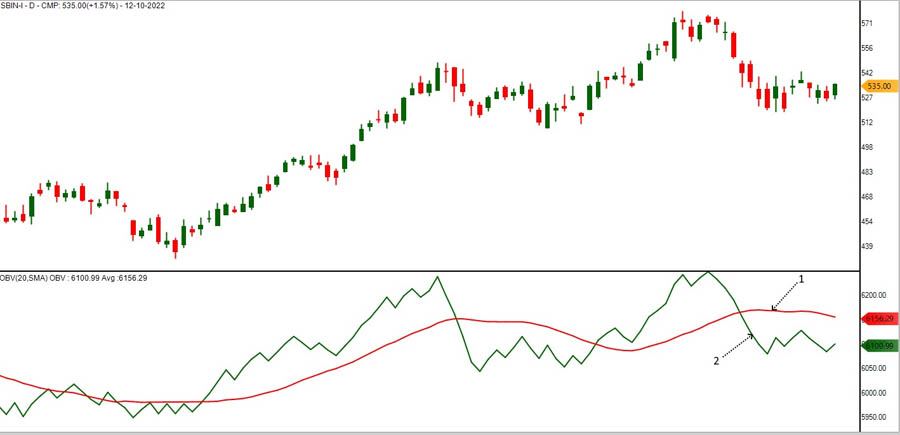
Key Benefits for Scalpers:
- Confirms trend strength
- Identifies potential breakouts
- Helps detect divergences between price and volume
Strategy for Using OBV in Scalping:
- Look for divergences between OBV and price action. If the price is making new highs, but OBV is not, it may indicate a potential reversal.
- Use OBV to confirm breakouts. A strong move in price accompanied by a surge in OBV suggests a valid breakout.
- Enter long positions when OBV is rising and short positions when OBV is falling, using price action to fine-tune entry points.
- Set stop-loss orders just below recent swing lows for long positions or above recent swing highs for short positions.
- Take profit when OBV shows signs of weakening or reversal.
2. Chaikin Money Flow (CMF)
Developed by Marc Chaikin, this indicator combines price and volume to measure buying and selling pressure over a specific period, typically 20 or 21 days.
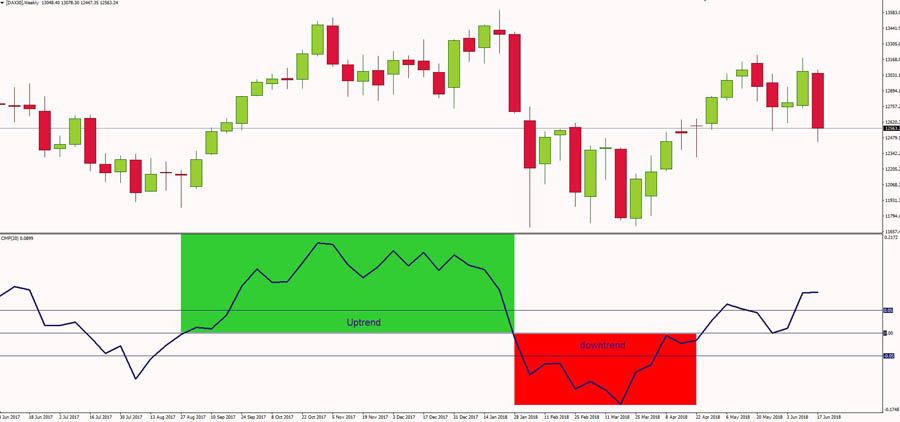
Key Benefits for Scalpers:
- Provides insights into accumulation and distribution patterns
- Helps identify overbought and oversold conditions
- Useful for confirming trend reversals
Strategy for Using CMF in Scalping:
- Look for CMF values above +0.05 to indicate bullish momentum and below -0.05 for bearish momentum.
- Enter long positions when CMF crosses above the zero line and short positions when it crosses below.
- Use CMF divergences to identify potential reversals. For example, if price makes new highs but CMF fails to do so, consider taking profit or preparing for a reversal.
- Combine CMF with support and resistance levels for more accurate entry and exit points.
- Set tight stop-loss orders based on recent price action, typically just beyond nearby support or resistance levels.
3. Volume Rate of Change (VROC)
The Volume Rate of Change indicator measures the speed at which volume is changing over a specified period. It’s particularly useful for identifying sudden surges in trading activity.
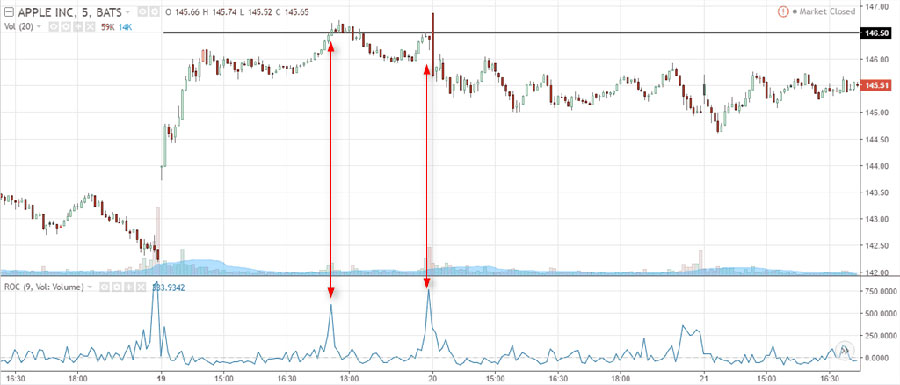
Key Benefits for Scalpers:
- Detects volume spikes that may precede significant price movements
- Helps identify potential breakouts or breakdowns
- Useful for confirming trend strength
Strategy for Using VROC in Scalping:
- Look for VROC spikes above 50% to indicate potential breakouts or strong trend continuation.
- Use VROC in conjunction with price action. Enter long positions when VROC spikes and price breaks above resistance, or short positions when VROC spikes and price breaks below support.
- Be cautious of false signals by confirming VROC spikes with other indicators or price patterns.
- Set stop-loss orders just beyond the recent price swing in the opposite direction of your trade.
- Take profit when VROC begins to decline, indicating a potential slowdown in momentum.
4. Money Flow Index (MFI)
Often referred to as the “volume-weighted RSI,” the Money Flow Index combines price and volume data to measure buying and selling pressure.
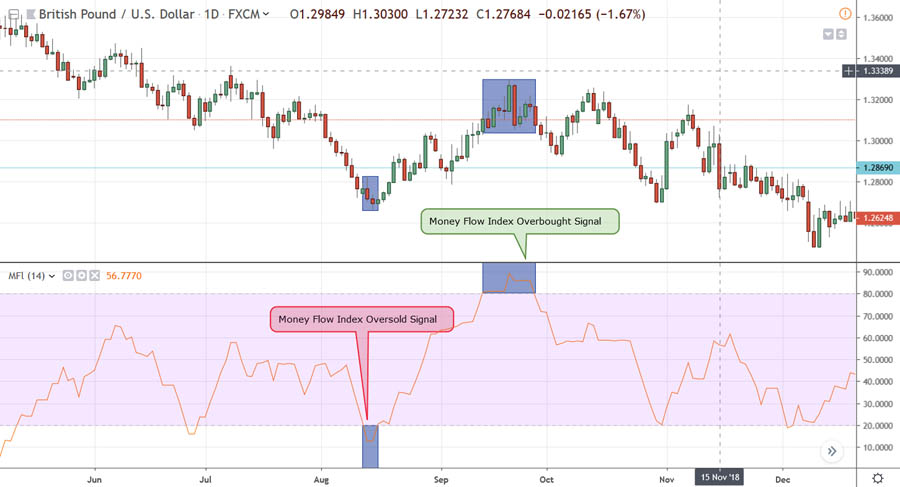
Key Benefits for Scalpers:
- Identifies overbought and oversold conditions
- Helps detect potential trend reversals
- Useful for confirming price action
Strategy for Using MFI in Scalping:
- Look for overbought conditions (MFI above 80) to identify potential short entries and oversold conditions (MFI below 20) for long entries.
- Use MFI divergences to spot potential reversals. For example, if price makes new highs but MFI fails to do so, consider taking profit on long positions or preparing for short entries.
- Combine MFI with trend lines or moving averages for additional confirmation.
- Enter trades when MFI crosses back into neutral territory (between 20 and 80) after being overbought or oversold.
- Set stop-loss orders beyond recent price swings and take profit when MFI approaches overbought or oversold levels in the direction of your trade.
Read More: Comprehensive Guide to Multi-Timeframe Scalping Strategy
5. Volume Weighted Average Price (VWAP)
VWAP calculates the average price of an asset weighted by volume. While primarily used in stock trading, it’s gaining popularity among forex scalpers.
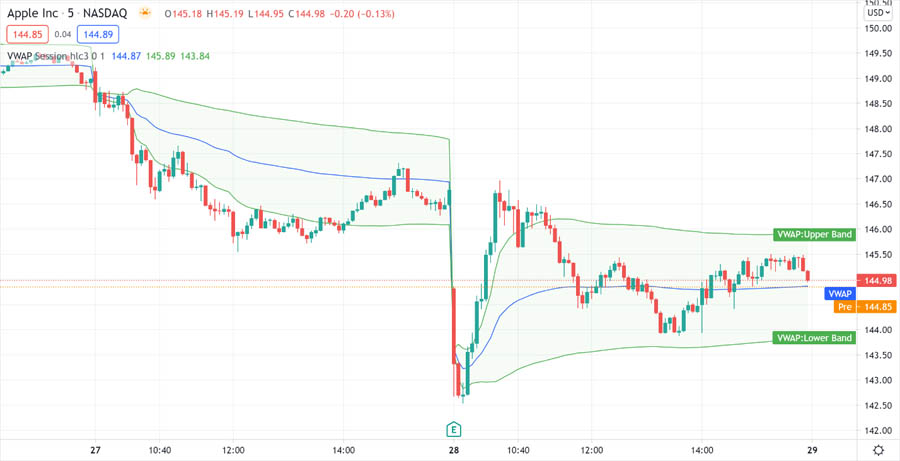
Key Benefits for Scalpers:
- Provides a benchmark for fair value
- Helps identify potential support and resistance levels
- Useful for determining optimal entry and exit points
Strategy for Using VWAP in Scalping:
- Use VWAP as a dynamic support and resistance level. Look for bounces off VWAP for potential entries.
- Enter long positions when price moves above VWAP and shows signs of continued upward momentum.
- Enter short positions when price falls below VWAP and shows signs of continued downward momentum.
- Combine VWAP with other volume indicators for confirmation. For example, look for OBV or CMF to support the direction of your trade.
- Set stop-loss orders just beyond the opposite side of the VWAP line and take profit when price shows signs of returning to VWAP.
Implementing Volume Indicators in Your Scalping Strategy
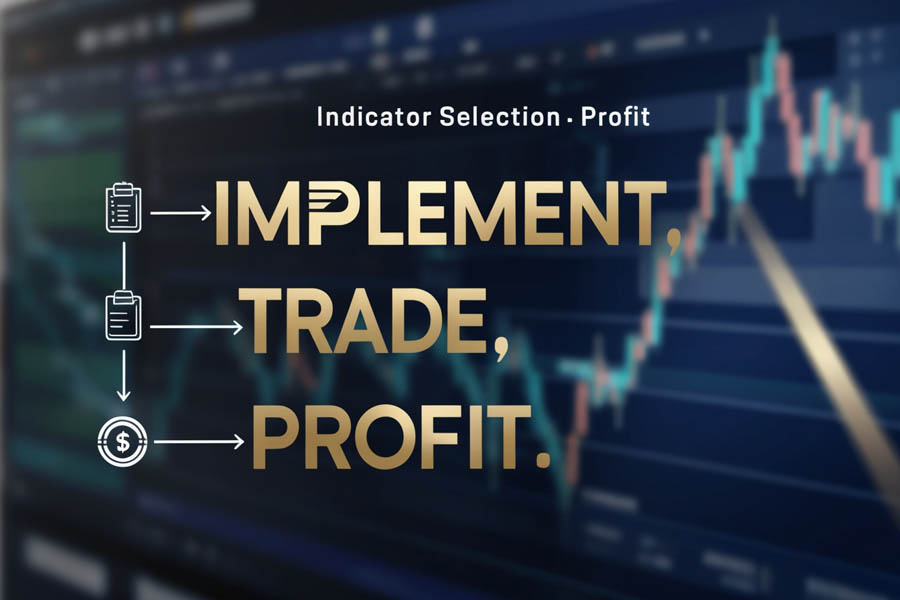
Step 1: Choose the Right Timeframe
For scalping, focus on shorter timeframes such as 1-minute, 5-minute, or 15-minute charts. These timeframes provide the granularity needed for quick entries and exits.
Step 2: Combine Multiple Indicators
While volume indicators are powerful on their own, combining them with other technical tools can enhance your analysis. Consider pairing volume indicators with:
- Moving averages
- Fibonacci retracements
- Support and resistance levels
Step 3: Look for Convergence and Divergence
Pay attention to situations where volume indicators converge with or diverge from price action. These scenarios often signal potential trend continuations or reversals.
Step 4: Practice Risk Management
Always use stop-loss orders and adhere to strict risk management principles. Volume indicators can help you fine-tune your entry and exit points, but they should be used in conjunction with a comprehensive risk management strategy.
Step 5: Backtest and Refine
Before implementing volume indicators in live trading, backtest your strategy using historical data. This will help you understand how the indicators perform under various market conditions and allow you to refine your approach.
Advanced Techniques for Volume-Based Scalping
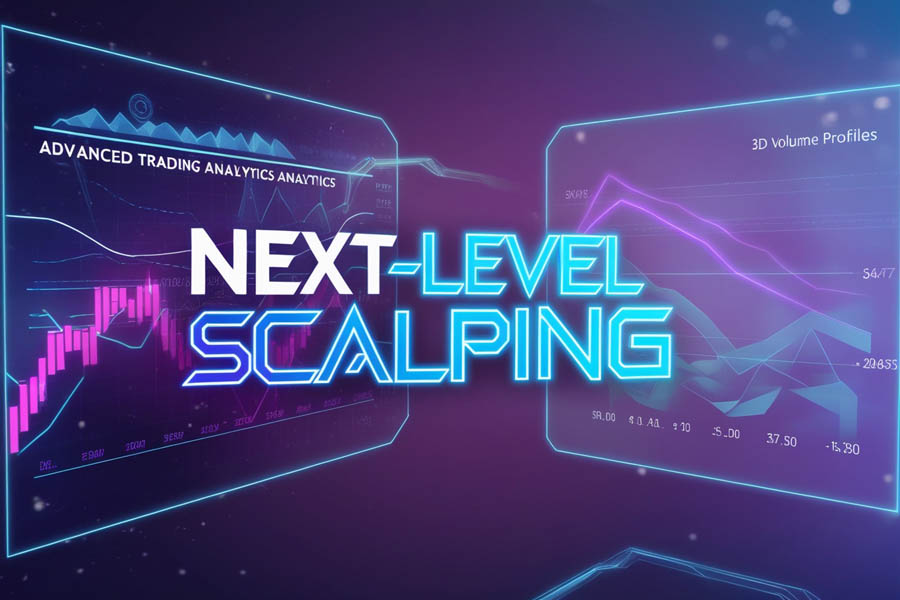
1. Volume Profile Analysis
Volume profile analysis involves studying the distribution of volume at different price levels. This technique can help scalpers identify key support and resistance areas based on trading activity.
How to Use Volume Profile in Scalping:
- Identify high-volume nodes (areas of significant trading activity) as potential support or resistance levels.
- Look for low-volume nodes as potential areas for price to move through quickly.
- Use the Point of Control (POC) – the price level with the highest trading volume – as a key reference point for your trades.
2. Delta Volume Analysis
Delta volume analysis focuses on the difference between buying and selling volume. By understanding the balance between buyers and sellers, scalpers can gain insights into potential price direction.
Implementing Delta Volume in Your Strategy:
- Look for positive delta volume to indicate bullish pressure and negative delta volume for bearish pressure.
- Use delta volume divergences with price to identify potential reversals.
- Combine delta volume with support and resistance levels for more accurate entry and exit points.
3. Footprint Charts
Footprint charts combine price, volume, and order flow data into a single visual representation. While more complex than traditional volume indicators, footprint charts can provide deeper insights into market dynamics for advanced scalpers.
Scalping with Footprint Charts:
- Identify imbalances between buying and selling volume at specific price levels.
- Look for absorption (high volume with little price movement) as potential reversal points.
- Use footprint patterns like “Decimal Breaks” or “Trapped Traders” for entry signals.
4. Volume-Weighted Moving Averages
By incorporating volume data into moving average calculations, scalpers can create more responsive and accurate trend-following indicators.
Using Volume-Weighted Moving Averages in Scalping:
- Enter long positions when price crosses above the volume-weighted moving average and short positions when it crosses below.
- Use multiple timeframe analysis by combining volume-weighted moving averages from different periods.
- Look for divergences between price and the volume-weighted moving average for potential reversal signals.
Read More: MACD Indicator for Scalping
Common Pitfalls to Avoid When Using Volume Indicators for Scalping
- Over-reliance on a Single Indicator: Avoid basing your trading decisions solely on volume indicators. Always consider multiple factors and confirm signals with other technical tools.
- Ignoring Market Context: Volume patterns can vary depending on market conditions, news events, and trading sessions. Always interpret volume indicators within the broader market context.
- Neglecting Time Zones: Remember that forex volume can fluctuate significantly based on the active trading sessions. Be aware of how different time zones affect volume patterns in your chosen currency pairs.
- Misinterpreting Low Volume: Low volume doesn’t always indicate a lack of trading opportunities. Sometimes, it can signal a potential breakout or trend reversal.
- Failing to Adapt: Market conditions change, and so should your strategy. Regularly review and adjust your use of volume indicators to ensure they remain effective in current market conditions.
OpoFinance: Your Trusted Partner for Volume-Based Scalping
When it comes to implementing volume-based scalping strategies, having a reliable and regulated forex broker is crucial. OpoFinance, an ASIC-regulated broker, offers a robust platform tailored to the needs of scalpers and day traders alike.

Key Benefits of Trading with OpoFinance:
- Advanced Trading Platforms: Access to state-of-the-art trading platforms with integrated volume indicators and customizable charting tools.
- Competitive Spreads: Tight spreads ideal for scalping strategies, allowing you to capitalize on small price movements.
- Fast Execution: Lightning-fast order execution, essential for successful scalping in volatile markets.
- Social Trading: Benefit from OpoFinance’s social trading service, allowing you to learn from and copy successful traders’ strategies.
- Secure Transactions: As an MT5 broker, OpoFinance offers safe and convenient deposit and withdrawal methods, ensuring the security of your funds.
By choosing OpoFinance as your forex trading partner, you gain access to the tools, resources, and support needed to implement volume-based scalping strategies effectively and responsibly.
Conclusion
Volume indicators are invaluable tools for forex scalpers, offering deep insights into market dynamics and helping traders make more informed decisions. By understanding and effectively implementing volume indicators such as OBV, CMF, VROC, MFI, and VWAP, scalpers can enhance their ability to identify profitable trading opportunities and manage risk.
The strategies and techniques outlined in this guide provide a solid foundation for incorporating volume analysis into your scalping approach. Remember that successful scalping requires a combination of technical analysis, disciplined risk management, and continuous learning. As you integrate these volume-based strategies into your trading, remain adaptable and always be willing to refine your approach based on market conditions and your own trading experiences.
Keep in mind that while volume indicators can significantly enhance your scalping performance, they are not infallible. Always use them in conjunction with other technical and fundamental analysis tools, and never neglect proper risk management practices.
With practice, dedication, and a commitment to ongoing education, volume-based scalping can become a powerful technique in your forex trading arsenal. By mastering these indicators and strategies, you’ll be well-equipped to navigate the fast-paced world of forex scalping, potentially leading to more consistent profits and greater trading success.
How do volume indicators work in the 24-hour forex market?
Volume indicators in forex work differently compared to stock markets due to the decentralized nature of forex trading. Instead of actual trade volume, forex volume indicators typically use tick volume or trading activity as a proxy. This approach still provides valuable insights into market momentum and potential price movements, making volume indicators effective tools for forex scalpers.
How do volume indicators work in the 24-hour forex market?
While volume indicators can’t predict market reversals with 100% accuracy, they can provide strong signals of potential reversals, especially in short timeframes used for scalping. Sudden spikes in volume or divergences between price and volume often precede reversals. However, it’s crucial to use volume indicators in conjunction with other technical analysis tools and confirm signals before making trading decisions.
Can volume indicators predict market reversals in scalping timeframes?
The frequency of recalibrating volume indicators depends on market conditions and your specific trading strategy. As a general rule, review your indicator settings at least monthly, or more frequently if you notice a decline in their effectiveness. Pay attention to changes in market volatility, trading session patterns, and your own trading results to determine when recalibration might be necessary. Regular backtesting can also help you optimize your volume indicator settings for current market conditions.







